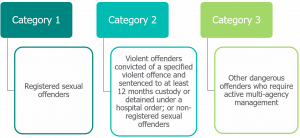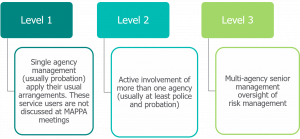Multi-agency public protection arrangements
Key findings
- The introduction of multi-agency public protection arrangements in the early 2000s is associated with significant falls in serious reoffending. However, without a control group we cannot be entirely confident about causality.
- Critical success factors include effective communication, information sharing, enhanced access to services, and rapid responses to escalating risk or deteriorating behaviour.
- Defensible decision-making at every level from practitioner to senior leadership is crucial to public protection. Defensibility is only possible where evidence-based practice and effective supervision skills have been deployed. Agencies working with high-risk service users must also ensure that their staff have access to validated assessment tools.
Background
Multi-agency public protection arrangements (MAPPA) were introduced in 2001 with the aim of improving inter-agency collaboration. They are organised at the police force area, with probation, the police and prison service coming together to form the MAPPA Responsible Authority area. Other agencies, such as the NHS or local authorities, have a duty to cooperate with MAPPA. All should work together locally to identify, assess and manage those individuals who pose a higher risk of harm to others.
There are three categories of MAPPA service user and they are managed at three differing levels:


Key statistics are as follows:
- at the end of March 2019, there were 82,921 MAPPA nominals in England and Wales, a rise of 85 per cent since 2009
- 73 per cent of MAPPA nominals were registered sexual offenders
- the vast majority (98.2 per cent) were subject to Level 1 management, with 1.6 per cent at Level 2 and 0.2 per cent at Level 3
- 0.16 per cent (130 MAPPA nominals), were reconvicted in 2018/2019.
Summary of the evidence
MAPPA and reducing reoffending
An evaluation of MAPPA found reduced reoffending of eligible service users since the beginning of the MAPPA initiative. The one-year proven reoffending rate for violent and non-registered sexual offenders decreased from 26 per cent in 2000 (that is, before MAPPA) to 23 per cent in 2004. For those service users presenting the highest risk of serious harm, reoffending fell from 29 per cent to 16 per cent between 2000 and 2010.
The authors note that the most frequent reoffences committed within one year by MAPPA eligible offenders were classified as non-serious.
Effective practice in MAPPA
An evaluation of Level 2 and 3 multi-agency MAPPA management identified the following critical success factors:
- effective communication among police, probation and prisons is important post-release for high-profile cases and service users presenting a high risk of serious harm
- systematic exchange of information enables the lead agency to manage the service user with the best possible intelligence
- enhanced access to services is required, especially for the highest risk cases. Access to housing is particularly important in challenging cases
- good links with social services are vital for child protection, especially identifying ‘at risk’ children and potential victims
- priority should be given to victim liaison, especially when rehousing MAPPA service users
- MAPPA approved discretionary disclosure is especially important in consideration of employment, residence near schools, and suspected grooming activities
- rapid response is required for escalating risk or deteriorating behaviour, for example, by calling an emergency meeting, reviewing plans, providing assistance in finding services (for example, housing or mental health services)
- an option to continue supervision beyond the end of licence is also important for challenging cases.
Defensible decision making
A defensible decision is a decision that will withstand ‘hindsight scrutiny’ should negative outcomes (serious further offending or a ‘near miss’) occur. It has been recognised that there are many challenges, at all levels, to making defensible decisions when managing dangerous people. In particular, there is a need to be mindful of the biases and cognitive distortions all humans are prone to, such as confirmation bias, deference to authority, and unreal optimism.
Defensible decision making, and mitigation of biases and error, can be supported through MAPPA staff:
- using validated assessment tools
- building and implementing sentence plans with service users on the basis of these structured assessments
- deploying effective supervision skills, e.g. encouraging desistance through pro-social modelling, recognising and building upon strengths, and enhancing social capital.
![]() Find out more about supervision skills
Find out more about supervision skills
The key task for practitioners is to act in transparent, defensible and evidential ways, seeking an appropriate balance in each individual case between risk and rights, protection and integration, desistance supportive work and control.
The 2020 Hall Review of MAPPA for managing terrorist offenders identified some similar themes. There was an over-reliance on OASys (Offender Assessment System) assessments, failures to share prison and other security intelligence, and optimism bias about the progress made in prison. The review concluded that MAPPA should shift from formal periodic meetings to active case management by a core group of professionals from police, probation and prisons.
Bryant, S., Peck, M. and Lovbakke, J. (2015). Reoffending Analysis of MAPPA Eligible Offenders. London: Ministry of Justice.
Kemshall, H. and Wood, J. (2007). ‘Beyond public protection: An examination of community protection and public health approaches to high-risk offenders’, Criminology & Criminal Justice, 7(3), pp. 203–222.
Kemshall, H. (2009). ‘Working with sex offenders in a climate of public blame and anxiety: How to make defensible decisions for risk’, Journal of Sexual Aggression, 15(3), pp. 331-343.
Back to Specific types of delivery Next: Integrated Offender Management
Last updated: 17 May 2021



